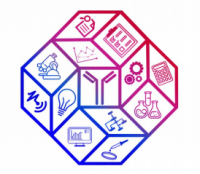LxUs 2019
LxUs is a team from the University of Lisbon competing in the SensUs 2019 event. For SensUs 2019, LxUs investigated the possibilities for creating a biosensor which is able to measure the concentration of Adalimumab. The full TRD can be found [ via this link]
Method
The working principle is based upon the spectrophotometry technique which allows transduction of changes in optical properties of the 60 nm dimater Au-NP, functionalized with anti-ADL antibodies. The detection system is comprised of a 405 nm laser, as the light source, and a photodiode as a detector, allowing for the transduction of the light transmitted through the cuvette into an electric signal. This signal is then amplified, processed and fed into an Arduino board with a Bluetooth module streaming of the results to a smartphone application that displays and records them for future monitoring.
Molecular Recognition
The LxUs biosensor working principle is the measurement of changes in the optical properties of a solution of gold nanoparticles (Au-NP) functionalized with biotin as they bind to Adalimumab (ADL) molecules. These changes are proportional to the concentration of ADL. The absorbance peak of Au-NP shifts to higher wavelengths as the particles bind to a ligand (the ADL), increasing their radius. By increasing or decreasing the concentration of ADL, the absorbance value changes proportionally. For this purpose, Au-NP, 60 nanometre diameter, pegylated (PEG 5000) and biotin terminated were employed (Sigma-Aldrich, product code 808911) together with anti-ADL antibodies for molecular recognition. For assays, lyophilized human plasma (Sigma-Aldrich, product code P9523) and anti-TNF-/alpha (Adalimumab) (Biovision Incorporated, catalog number A1048) were used.
Physical Transduction
The biosensor is based on the spectrophotometry technique to obtain the concentration of ADL present in the sample. For that, a collimated laser diode (Thorlabs, part number CPS405) with a 405 nm wavelength is used with a corresponding photodiode. The beam crosses a cuvette (Sigma-Aldrich, product code C5291) containing the sample and the transmitted intensity is then converted to an electric potential by the photodiode. This signal is amplified by a negative-feedback amplifier circuit, sent to an Arduino UNO board and the corresponding sample concentration transmitted via Bluetooth to a smartphone application. Schematic of the device apparatus is show in figure 1. The measured values allow calculation of the sample’s concentration of ADL bound to the Au-NP. Obtaining data in order to create a calibration curve enables the computation of the sample’s ADL concentration on the Arduino UNO board.
Cartridge
Polystyrene cuvettes (Sigma-Aldrich, product code C5291) with two polished windows for the light measurement step, placed in a cuvette holder.
Reader Instrument
To ease the interaction between user and device, an intuitive smartphone application was created. It allows creation of patient profiles and storage of their respective test results. As such, any Android smartphone can be used as a reader instrument for the LxUs biosensor. The application was developed using OutSystems. Communication with the biosensor is performed via Bluetooth, namely a module connected to the Arduino UNO board. The user needs only to insert a small cuvette containing the solution of plasma, Au-NPs and ADL in the equipment. By pressing a button in the application, the ADL concentration is shown on the screen. When the application is accessed, the main screen presents three options: New Patient, Patient List, New Analysis. The “New Patient” screen allows for the user to create a profile. Once the user has finished filling out the new patient’s profile, they can click save to add it to the Patient Profile List. The “Patient List” screen lists all the patient profiles the user has created so far. Clicking on one of the names opens the Patient Profile of your choice, providing the user with even more options. If the “More Details” option is clicked, the user will be shown the most important information of the patient’s data. The “New Analysis” option takes the user to a screen which allows communication with the LxUs biosensor. The user will then be able to turn on the Bluetooth of their mobile device and begin the sample analysis by pressing a button. Once the sample testing finishes, the results will be shown on the screen.
